
|

| |
|
This section presents the Publishable Reports compiled and published in the framework of the WaterStrategyMan Project. Volumes compile a series of critical research results of the WSM Project, starting from an analysis of the range of circumstances in fifteen Mediterranean Regions, continuing with the development of a methodology and the WSM Decision Support System, and escalating with the development of guidelines for different management options and methods, and the formulation of improved water management strategies.
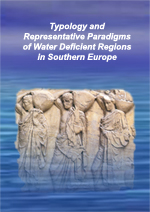 |
Typology and Representative Paradigms of Water Deficient Regions in Southern Europe
A key step in analysing water deficient regions in the framework of the WaterStrategyMan project was the formulation of a typology that describes the entire range of circumstances in terms of water resources availability, water supply options, water policy options, as well as institutional and socio-economic conditions. This volume presents a thorough investigation of fifteen regions in the Mediterranean basin, analysing prevailing conditions in terms of natural conditions, human pressures, adopted responses, water policies and constraints to solving water deficit problems.
Regions presented and analysed in this volume are Attica, Thessaly and Cyclades in Greece, Emilia-Romagna, and Belice Basin in Italy, Tel Aviv and Arava regions in Israel, Germasogeia, Akrotiri and Kokkinokhoria in Cyprus, Canary Islands and Donana in Spain, and Guadiana, Sado and Ribeiras do Algarve in Portugal.
PDF Version - File size 6.8 MB |
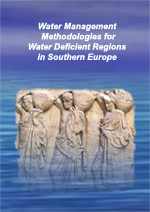 |
Water Management Methodologies for Water Deficient Regions in Southern Europe
This volume is based on a thorough investigation of fifteen regions in the Mediterranean and reviews some of the concepts and methods that are useful for river basin management. It is organised in the following manner: Chapter 1 summarises models for the assessment and forecasting of water availability and demand, taking into account temporal and spatial variability and water shortage conditions. The aim of Chapter 2 is to present a methodological approach for the estimation of financial, resource and environmental costs associated with water management interventions and uses. The different sections of this chapter analyse the theoretical background for the estimation of the different components of the cost and propose a simplified, easy-to-implement approach for their computation. Chapter 3 outlines different methods for MCDM in water resources management and describes basic requirements for indicators to “measure” the achievement of a given objective in the planning process. Finally, data requirements, structuring approaches and the most commonly used indicators in water resources management are presented in Chapter 4.
PDF Version - File size 1.7 MB |
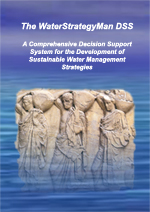 |
The WaterStrategyMan DSS: A Comprehensive Decision Support System for the Development of Sustainable Water Management Strategies
Volume III of the WSM Publishable Reports presents the Decision Support System developed in the framework of the WaterStrategyMan project. The WSM DSS was functional to the analysis of the dominant and shifting paradigm options and of their quantitative, qualitative and economic impacts in the selected regional water resource systems. The primary aim was to develop a tool, able to simulate the behaviour of water resource systems under different scenarios of water availability and demand, and including a module for simulating and evaluating alternative water management strategies. Its implementation was preceded by a comprehensive review of existing suitable methodologies and models for water resources and an analysis of their strong and weak points led to the definition of the present architecture of the DSS.
The volume is structured in two parts: Part I presents the principles, concepts and methodology of the WaterStrategyMan DSS, while Part II is a comprehensive review of existing tools for water management and planning.
PDF Version - File size 6.2 MB |
|
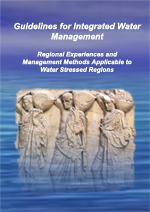
|
Guidelines for Integrated Water Management: Regional Experiences and Management Methods Applicable to Water Stressed Regions
This report provides Guidelines for Water Management methods and options examined in the process of development of suitable water management strategies for water deficient regions. Guidelines are given as a set of instructions that analyze a given strategy into actions required within the selected water management options, set within a suitable but flexible time framework. The document aims at enabling the dissemination of the Project results, by providing a step-by-step analysis of the specific options to be used within the framework of a strategy and their specifications (relative costs,duration, and project lifetime). Case Study regional experiences in the application of these options have been included, in order to provide input based on hands-on experience.
PDF Version - File size 3.0 MB |
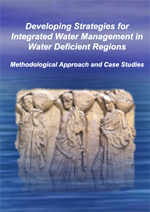 |
Developing Strategies for Integrated Water Management in Water Deficient Regions: Methodological Approach and Case Studies
This volume outlines a methodology for the formulation and evaluation of improved and integrated water management strategies for water deficient regions. The methodology consists of a number of steps for the identification and selection of the stakeholders, a procedure for stakeholder consultation in order to identify objectives, goals and responses, the evaluation of different options, and the formulation of a new strategy founded on the principles of Integrated Water Resources Management. he approach is complemented through the development of appropriate cost recovery strategies taking into account the principle for the recovery of costs and the adequate contribution of water use sectors, in line with the requirements of the Water Framework Directive. This volume is structured in two Parts. Part I (Chapters 1 to 8) elaborates on the principles and the methodology developed for the formulation and evaluation of improved, integrated water management strategies. Chapters 3 to 7 present the validation of this methodology, and the results from its application in five Case Studies of the WaterStrategyMan project. Part II is dedicated to the presentation of the outcomes of a building block of this methodology, elaborating on results from the evaluation of different applicable options in the analysed regions. The aim of this evaluation, in the broader objective of Strategy Development, was to select, out of a range of proposed management methods, those that can be most effective and efficient in alleviating water scarcity related issues.
PDF Version - File size 7.6 MB |
 |
Protocols for the Implementation of Improved Water Management Strategies in Water Deficient Regions
This volume provides a preparatory framework for Protocols for the implemention of improved water management strategies in water deficient regions. A protocol is defined as a comprehensive set of measures for the regulation of human activities and the preservation of the environment. On the basis of Integrated Strategies, formulated in the course of the WaterStrategyMan project, this report aims to present an initial analysis of regional requirements for their implementation. These requirements are primarily classified in terms of institutional reforms, education and awareness campaigns, cost recovery issues and impact mitigation requirements.
The document is structured in 3 chapters: The first chapter provides an overview on the evolvement of protocols and protocol types. Chapter 2 presents protocols aimed at dealing with water deficiency and water stress issues. Finally, Chapter 3 presents, for each WSM Case Study, (a) the background in the formulation of water management policies, (b) a brief presentation of stakeholders and actors directly involved or influenced by the decision making process, (c) the final outcomes of the strategy formulation process, and (d) additional considerations regarding the implementation of these, aiming to define a framework for the determination of the enabling environment for their implementation.
PDF Version - File size 2.0 MB |
Top
|
| |
|